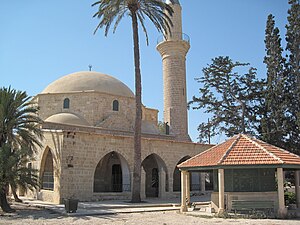Hala Sultan Tekke
| Hala Sultan Tekke | |
|---|---|
| Hala Sultan Tekkesi / Τεκές Χαλά Σουλτάνας | |

Hala Sultan Tekke
|
|
| Basic information | |
| Location |
|
| Geographic coordinates | 34°53′07″N 33°36′36″E / 34.885277°N 33.610013°ECoordinates: 34°53′07″N 33°36′36″E / 34.885277°N 33.610013°E |
| Affiliation | Islam |
| District | Larnaca District |
| Architectural description | |
| Architectural type | Mosque |
| Architectural style | Ottoman |
| Specifications | |
| Dome(s) | Two |
| Minaret(s) | One |
Hala Sultan Tekke or the Mosque of Umm Haram (Turkish: Hala Sultan Tekkesi ; Greek: Τεκές Χαλά Σουλτάνας) is a Muslim shrine on the west bank of Larnaca Salt Lake, near Larnaca, Cyprus. Umm Haram (Turkish: Hala Sultan) was the Islamic prophet Muhammad's wet nurse and the wife of Ubada bin al-Samit.
Hala Sultan Tekke complex is composed of a mosque, mausoleum, minaret, cemetery, and living quarters for men and women. The term tekke (convent) applies to a building designed specifically for gatherings of a Sufi brotherhood, or tariqa, and may have referred to an earlier feature of the location. The present-day complex, open to all and not belonging to a single religious movement, lies in a serene setting on the shores of the Larnaca Salt Lake, which appears to be an important site also in prehistory. Hala Sultan Tekke is a listed Ancient Monument.
During the second half of the second millennium B.C, the area of the Hala Sultan Tekke was used as a cemetery by the people who lived in Dromolaxia Vizatzia, a large town a few hundred metres to the West. A part of this town was excavated from the 1970s onwards by a Swedish archaeological mission and proved to be a major urban centre of Late Bronze Age Cyprus. The most recent excavations at Hala Sultan Tekke, The New Swedish Cyprus Expedition have been carried out by Professor Peter M. Fischer from the University of Gothenburg, Sweden (2010-2012- ...); see www.fischerarchaeology.se). Radar surveys (2010-2012) have demonstrated that the city was one of the largest in the Late Bronze Age (roughly 1600-1100 BCE), maybe as large as 50 ha. Another archaeological investigation conducted by the Department of Antiquities under the women's quarter of Hala Sultan Tekke have revealed building remains dated to the late Archaic, Classical and Hellenistic periods (6th - 1st century BC). Several finds indicate that the site might have been used as a sanctuary but the limited scale of the investigations precludes definite conclusions about its use.
...
Wikipedia
